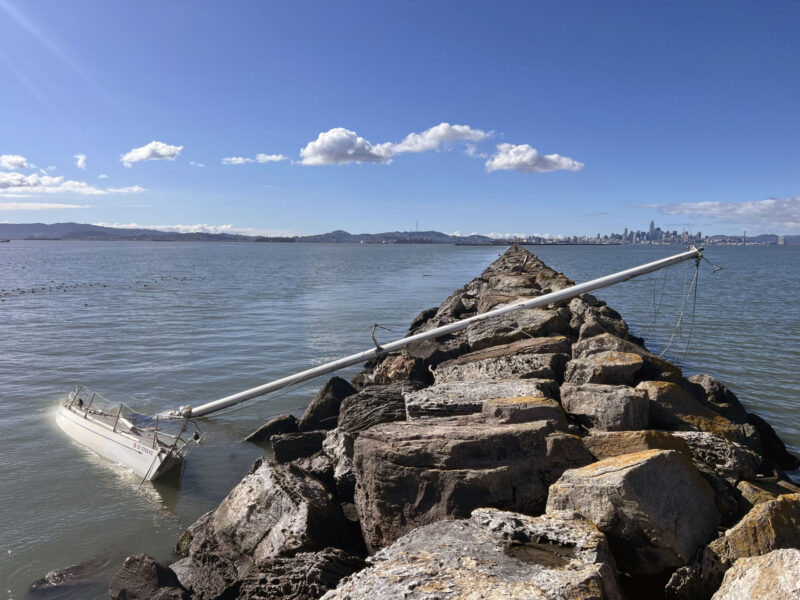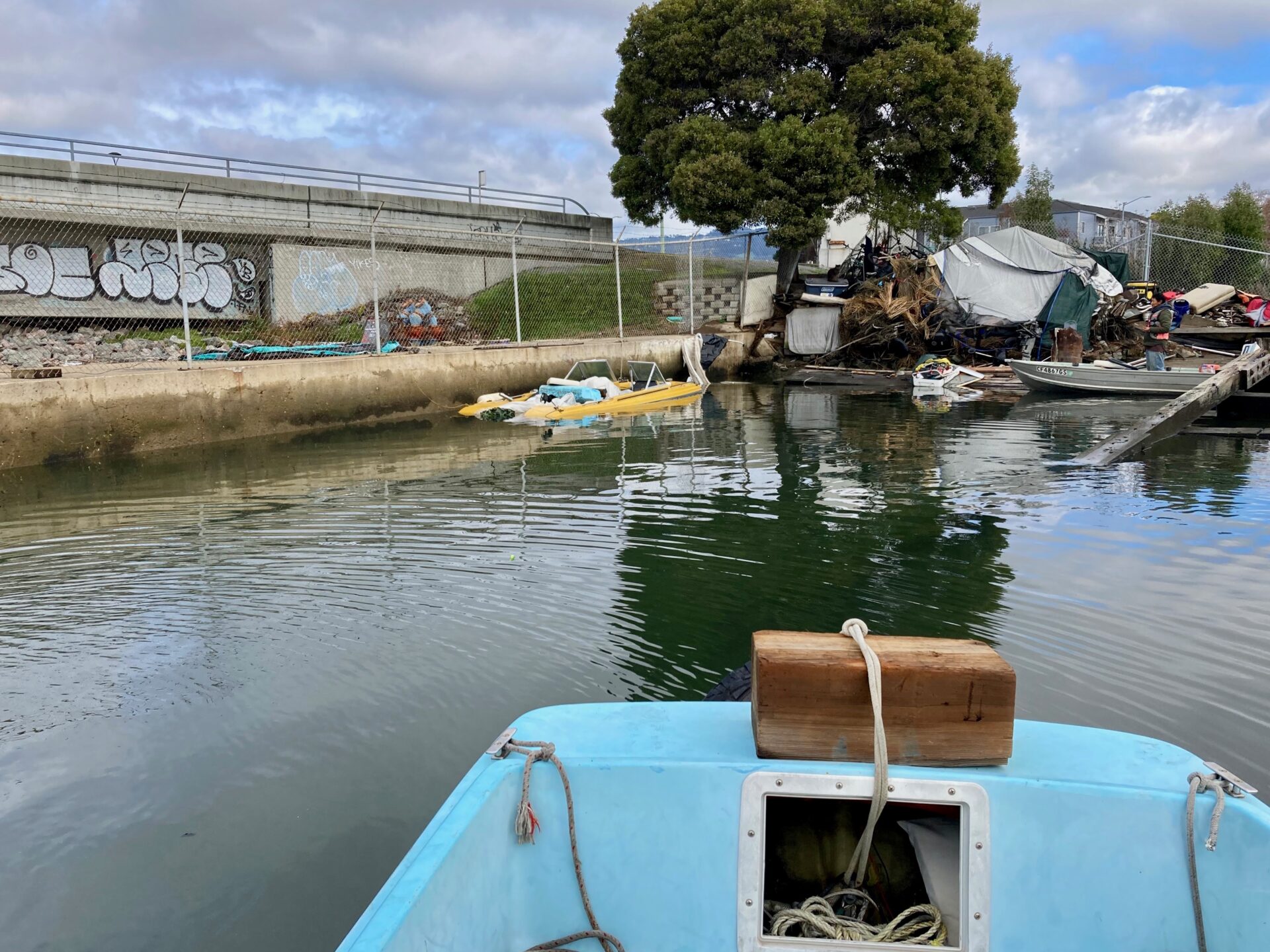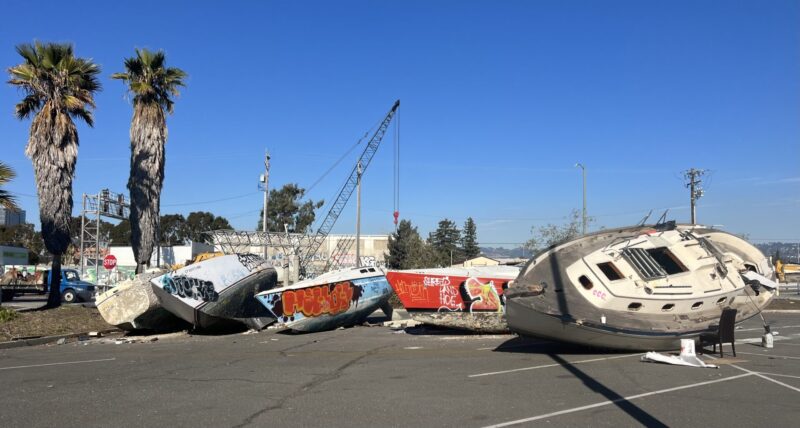
As Oakland Estuary Sees Improvement, Cities Around the Country Deal With Derelict Vessels
After a harrowing summer of what was dubbed a “pirate crime spree” on its shores — and after several years of lax enforcement by police — grant money has poured into the Oakland Estuary, marine units are back on patrol, and at least 25 derelict vessels have been removed. “Eighteen were taken from the waterway and crushed,” said former harbormaster Brock de Lappe. “Seven left on their own accord to other parts of the Bay; two anchor-outs have been eluding enforcement by moving back and forth across the Estuary from Oakland to Alameda.”
As we reported on Monday, a sailboat apparently broke loose and slammed into a breakwater in Alameda, where it eventually sank. It’s not clear if this boat was one of the roaming anchor-outs described, but regardless, de Lappe said that the City of Alameda will be contracting a salvager to remove the wreck.
While there’s been a long-running debate over anchor-outs in the Bay Area, the problems here are by no means unique. “You’ll have vagrants squatting on the boat [and] it falling apart; there have been several instances where the boats have come loose and ran into docks,” said a sheriff in Martin County, Florida, just north of West Palm Beach. In an attempt to target boats in the Miami area, a Florida state bill proposes to ban overnight anchoring for all vessels in parts of Biscayne Bay. Cruising advocates are up in arms over the bill, but the pressures of homelessness continue to collide with boating interests, infrastructure, and boats themselves. Once a vessel has fallen into disrepair or reached the end of its useful life, it’s worth nothing on the market, but has a huge price tag for disposal and removal — especially if it’s wrecked in the water. Such a vessel, however, is invaluable to an unhoused person seeking shelter.

In last month’s Sightings, we noted the strange sense of déjà vu on the Estuary: There was a $7 million cleanup of derelict vessels in 2013, where some 50 boats — including as many as 25 liveaboards — were removed. Up until 2019, the lone Oakland Police marine unit was still patrolling the Estuary and tagging boats. After a lawsuit against the Oakland PD in 2019, there was virtually no enforcement until late last year. The number of anchor-outs boomed in the interim. Brock de Lappe has long maintained that as long as there’s rigorous enforcement, anchor-outs can’t take root again.
Only time will tell how the cities of Oakland and Alameda manage and patrol the Estuary. Oakland marine officer Kaleo Albino “made the plea that temporarily assigned OPD personnel become permanently assigned to the marine unit so that he can maintain regular on-the-water patrols to protect the Estuary from the problem recurring,” de Lappe said.
“For the record, the Estuary is now the cleanest it has been in years,” he added.
Though theft appears to have subsided, a work/tow boat was stolen from Alameda Marina a few weeks ago. “It was found along the Oakland side of the Estuary at an encampment near Coast Guard Island,” Eileen Zedd, the harbormaster at Alameda Marina, said in an email. “We retrieved the vessel along with other stolen property. We made a report with [Alameda Police Department]. Of course, they said for the other items on the other side we would need to contact Oakland PD.”

There are hundreds of thousands of boats registered in California — the fourth-most in the nation — according to the Mercury News. “The state’s $10 billion recreational boating community supports tens of thousands of jobs. But the state has few comprehensive plans for disposing of aging or abandoned boats. In order to gain ownership of the abandoned boat, allowing them to access funds that will help them remove it, marinas must undertake a months-long lien process. They may have to pay hundreds or even thousands in back taxes to the county. Meanwhile, the boat takes up a slip, no longer making any money for the business. To avoid that outcome, some marina operators have long sold abandoned boats to interested buyers for as little as one dollar,” thus proliferating the fleet of derelict vessels/homeless shelters.
“There’s this cycle that repeats itself,” Alameda harbormaster Eileen Zedd told the Mercury News. “It’s hard for marina operators to deal with these situations. There’s just not much help out there.”

While the Oakland Estuary has long been a recreational hub for sailors, paddlers, swimmers, etc., it’s not necessarily a cruising destination — certainly not like Biscayne Bay.
“These anchorage grounds are often used by responsible cruising boaters for re-provisioning and waiting for a safe weather window as a jumping-off point for the Bahamas and Caribbean,” Cruising World wrote. With two bills set to go into effect on July 1 that would ban overnight anchoring within 200 yards of seven islands in Biscayne Bay, the state of Florida is “struggling to balance the rights of responsible boat owners against the owners of poorly maintained, derelict vessels,” Cruising World said, echoing identical concerns seen here in the Bay. “These vessels, which have little to no value, wash up ashore and are frequently abandoned after storms, leaving taxpayers to foot the bill for removal.”
“It can be anywhere from $6,000 and upwards,” the Martin County sheriff said of salvage operations. “Astronomical amounts of money.”
Boating advocates in Florida are urging people to write lawmakers in protest of the proposed bill. BoatUS described the proposed anchor ban as an ineffective, whack-a-mole approach. “The reality is these bills will do nothing to decrease the number of derelict and at-risk vessels in Biscayne Bay; these boats will simply move to other areas. Using state law to prohibit anchoring takes away public access to a shared resource for the benefit of only a few waterfront property owners.”
“We’ve seen a tremendous increase, actually, throughout the county,” said the Martin County sheriff of derelict vessels. Fox News added, “Authorities [in Florida] cite cost of living issues for the increase of squatters and homeless people moving onto the boats.”

This cruiser avoids the bay area sadly because the officials would rather destroy boats than encourage boaters to be responsible and have annual check lists for safety and seamanship plus required rules for proper anchoring apparatus… Seems like Kaleo is a rare find that understands having a regular employee on the water to assist in the problem. Bottom line is a few bad apples spoil the water for everyone… On both sides of the issues.
Malama — It’s not accurate to call many of the people in question “boaters” who have simply fallen behind on maintenance and check lists. In the past decade, the majority of anchor-outs have been homeless people suffering from mental illness and addiction who understandably prefer to shelter in a non-operational boat rather than a tent on the street.
It’s just more of the PLASTIC problem. What do you do with old fiberglass? There should be a disposal fee built into the cost of any new boat. Or anything plastic, I am starting a war against plastic I hope.
When my fiberglass boat is at the end of its life it will be a burden to me and the environment to dispose of. It was a stolen and recovered boat that I saved and rebuilt. It was a few weeks away from getting cut up when I got it. Damm nice boat now after countless hours of my labor and 3 times what it’s worth in cash fixing it up. 1976 Pearson 30 that is brand new except for the hull. Would I do it again, hell no.
My 44′ Aluminum boat is worth something at the end of its boat life with an all wooden interior and aluminum hull. There is not much to it that cannot be recycled. Why are there so few aluminum boats in the US? In French Polynesia they are everywhere. Even a factory built Ovni has a wood interior not a plastic liner. They are at the lower end of aluminum boats in cost.
Next up homelessness, realistic affordable housing for those who can take care of themselves. And supervised living for those who can’t, group homes, mental health facilities, drug rehab, or send them to Texas. ( just had to get that in ) Get them off the water, street and public lands. That way people can use public lands / waterways as they were intended for recreation.
At least two problems: anchor outs and then just plain walking away from the boat. This is a huge problem in the Delta and last summer saw two sailboats drift to TI, where one sank and still sits and the other against the rocks by the toll plaza. They are not strictly navigational hazards so the Army COE won’t remove them. There should be a bay authority with responsibility and funding do deal with such junk.
In reading the article it states that in 2013 there was 7 million to clean up 50 boats. If I’m not mistaken that’s $140,000.00 per boat. That’s sad
A huge shout out to the Oakland and Alameda Marine Patrol units – especially Officer Albino and his team. Also to Brock for his constant effort to keep this “top of mind” for all. There is still a lot to be done to clean up the Estuary – and that will take concerted efforts to reduce the number of encampments, to reduce the impact of shoreline erosion, and to hold the line on crime. That said, bringing the illegal anchor outs down to a manageable couple vessels that are in active pursuit is a big step in the right direction. Thank you!
The analysis of $140,000 per vessel is a very inaccurate assumption.
Please see this link from NOAA Marine Debris Removal Program for details of the 2013 Oakland Estuary cleanup project:
https://marinedebris.noaa.gov/sites/default/files/ADV-Docs/NOAA_ADV_Case_Study_CA_OaklandEstuary.pdf
Briefly, the US Coast Guard spent over a million dollars to bring the DB General, the largest crane on the West Coast, down from Seattle. This crane and the largest local Dutra crane were used to raise two tugboats that we sunk along the Alameda shoreline. The reason these two tugs sunk, the Respect and the Captain Al, was that tweakers stole though hull fittings for metal scrap.
Additionally a tug and barge with hazardous materials was removed from San Leandro Bay and an old wharf was removed off Union Point Park. These were all substantial undertakings, far more expensive than the simple removal of anchor-out vessels.
The City of Oakland has recently applied for a new grant from the NOAA Marine Debris Removal program which will allow the removal of beached and sunken vessels in the Oakland Estuary. What is most important moving forward is for the City of Oakland to provide the necessary police personnel to Port Security Officer Kaleo Albino to allow ongoing marine patrols on the estuary. If you rigorously prevent the first anchor-out, there will never be 2,4,8,16… This will effectively end the reoccupation and cyclic cleanup operations.